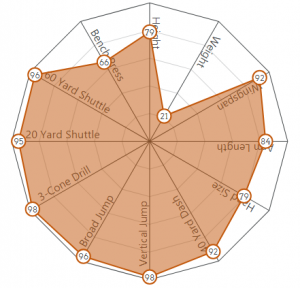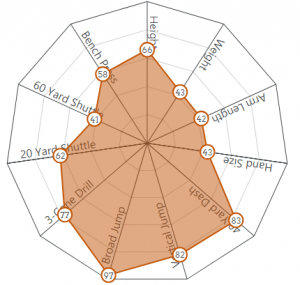What happened to the Mike Gesicki we were promised?
So, about Mike Gesicki….
The former second round draft choice of the Dolphins came in with a bevy of impressive highlight reels on social media and a set of measurements that had some referring to him as the most athletically gifted tight end the NFL Combine had ever seen.
Just look at this spider chart, via the MockDraftable website.
Sure, his weight (247 lbs.) came in perhaps 10 lbs. shy of distinction, and his height (6′ 5½”) has been bested by a few tight end prospects throughout the years. But the combination of the above has arguably never been seen.
For reference, compare the above chart to that of infamous Dolphins draft bust Michael Egnew, who became known for failure to deliver on his athletic promises (and for using his jersey number as his phone passcode):
In Dolphins training camp, Gesicki made “wow,” plays nearly every day.
Here’s just a taste of that action:
Dolphins 2nd round pick TE Mike Gesicki making a bit of a splash in Miami. He makes the plays that turn heads. pic.twitter.com/xuaWAzjtSE
— Chris Kouffman (@ckparrot) July 30, 2018
Fast-forward to the regular season and, according to Pro Football Focus, Mike Gesicki played a total of 400 of the offense’s 921 snaps, with 31 targets, 22 catches, 202 yards, and 0 touchdowns.
So…what gives?
In addition to obvious factors such as unacceptable quarterback play, low number of offensive snaps due to the offense’s inability to convert third downs, etc., the answer may lie in the rookie tight end’s usage.
When Gesicki and fellow rookie tight end Durham Smythe were drafted, Dolphins coaches such as offensive coordinator Dowell Loggains made it clear that while Smythe was considered a classic “Y” (in-line tight end), Gesicki’s primary role would be the “F” (off-formation or move tight end) position.
In some ways, this seemed immediately problematic.
Nowadays, NFL offenses have become completely reliant on what is known as “11” personnel, which is to say a group of personnel featuring only one running back and three wide receivers. This is a single-TE personnel grouping. According to Sharp Football Stats, the NFL used this “11” personnel group a staggering 65 percent of all plays in 2018.
Indeed, during the 2017 season head coach Adam Gase himself was at the forefront of “11” personnel usage. With a 73 percent share of the Dolphins offense’s snaps, only the Los Angeles Rams and Detroit Lions offenses showing a higher reliance on “11” personnel.
In order to get a lot of work out of an “F” in an offense dominated by single-tight end, three-wide receiver personnel groups, the offense would have to line up in a lot of spread formations. Over-reliance on spread formation can make the offense susceptible to blitzes, while simultaneously posing challenges to a successful run game.
A quarterback that lacks mobility would be particularly challenged within this approach, as there is more pressure on the quarterback to handle blitzes with his own ability. Coming off two knee injuries in two years, this did not bode well for quarterback Ryan Tannehill, nor his relatively immobile backup Brock Osweiler.
The reality of the team’s quarterback situation dictated that if the team were to stick with reliance on “11” personnel, rookie Mike Gesicki would have to spend a significant number of snaps being used as a “Y” lined up on the shoulder of the offensive tackle, despite the Dolphins coaches’ own assessment of the player.
Being forced into such usage meant the rookie Gesicki would have to block like a “Y” in the run game and stay in to pass protect when certain blitz fronts called for it. The in-line position is not conducive to clean releases on pass routes, and fans saw multiple instances of Gesicki losing his balance while trying to deal with the physicality.
To put it bluntly, he was put in positions and roles his own coaches publicly acknowledged to be incompatible with what he showed in college. And, when it was apparent he could not be relied on to carry out these roles, he came off the field altogether.
According to Pro Football Focus, Mike Gesicki lined up on the shoulder of the offensive tackle nearly half of all snaps (44 percent). He stayed in to pass protect on about 20 percent of pass snaps. He was the lone tight end on the field on 72 percent of the snaps he took as a rookie.
When Mike Gesicki was put in position to make plays, the rookie actually came through.
Among TEs with at least 30 catchable targets – Jack Doyle and Mike Gesicki tied for first by hauling in 100% of their targeted passes. pic.twitter.com/NSXASW8UD1
— Pro Football Focus (@PFF) April 2, 2019
Watching his full target reel on coaches tape was illuminating. He caught everything that was catchable, and he even made some things happen after the catch. He showed some ability to leverage off physical coverage and create his own windows. And he got open for some big plays that the quarterback missed.
The problem is one of frequency and opportunity. Those opportunities did not come often enough. If the Dolphins merely did the obvious, which would be to roll out multiple-tight end offensive personnel groups on a regular basis, that might have been different.
The Baltimore Ravens, who got impressive results out of rookie tight end Mark Andrews, used multiple-tight end personnel on 39 percent of their plays. The Philadelphia Eagles, who got impressive results out of rookie tight end Dallas Goedert, used multiple-tight end personnel on nearly 43 percent of their plays.
Back in 2010 the New England Patriots selected tight end Rob Gronkowski in the second round, followed by tight end Aaron Hernandez in the fourth round. It was very similar to the Dolphins selecting Gesicki in the second round and following up by choosing Durham Smythe in the fourth round.
But that is where the similarities end. From 2011 to 2012 the Patriots used multiple-tight end offense a staggering 66 percent of their plays, while in 2018 the Dolphins used multiple-tight end offense on only 16 percent of plays.
Aaron Hernandez played the “F” position in those New England offenses. He was on the field with other tight ends about 86 percent of his snaps. He only stayed in to block on 4 percent of pass plays. And he lined up on the shoulder of the offensive tackle only about 14 percent of plays.
I bring up those numbers not just because of their stark contract to Gesicki, but because they may be a harbinger of what we could see from Miami going forward.
Some of the coaches designing Miami’s offense, including offensive coordinator Chad O’Shea and tight ends coach George Godsey, were coaching that Patriots offense built around multiple tight ends. What’s more, last year the New England Patriots were one the offenses in the NFL that were least reliant on “11” personnel, bucking the league trend.
When the Dolphins signed tight ends Dwayne Allen and Clive Walford to join Durham Smythe and Nick O’Leary, many saw this as increased competition for tight end Mike Gesicki, who could easily fall far down the depth chart.
But all four of the other tight ends are classic “Y” players. None of the four players look, or play, like Mike Gesicki. Given the experience of Miami’s new offensive coaches, a more plausible explanation for the acquisitions of Dwayne Allen and Clive Walford might be an attempt to unlock Gesicki’s potential.
And if that happens, we just might see the Mike Gesicki we were promised.
Chris Kouffman (@CKParrot) is a fan of the Miami Dolphins and long, long, long Twitter threads. Find him here on the @3YardsPerCarry podcast.




Leave a Reply
Want to join the discussion?Feel free to contribute!